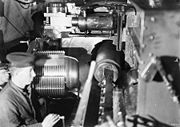| BL 12 inch gun Mk X | |
|---|---|
 | |
| Type | Naval gun |
| Place of origin |
|
| Service history | |
| In service | 1906 - 1920s |
| Wars | World War I |
| Production history | |
| Designer | Vickers |
| Manufacturer | Vickers |
| Specifications | |
| Mass | 57 tons barrel & breech[1] |
| Barrel length | 45 feet (13.72 m) bore (45 cal) |
|
| |
| Shell | 850 pounds (385.6 kg) Lyddite, Armour-piercing, Shrapnel[2] |
| Calibre | 12 inches (304.8 mm) |
| Breech | Welin interrupted screw |
| Muzzle velocity | 2,700 ft/s (823 m/s)[3] |
| Maximum firing range | 22,860 m (25,000 yd)[4] |
The BL 12 inch Gun Mark X[5] was a British 45-calibres naval gun which was mounted as primary armament on battleships and battlecruisers from 1906. It first appeared on the revolutionary HMS Dreadnought.
History[]


Mk X continued the trend of lengthening gun barrels as far as new construction methods would permit, in order to allow more cordite propellant to be used to attain higher projectile velocities. Mk X increased the bore length from Mk IX's 480 inches (40 calibres) to 540 inches (45 calibres), increasing muzzle velocity from 2,600 to 2,700 feet/second.
Subsequent British attempts to further increase the power of 12-inch guns led to failure with the 50-calibre Mk XI and Mk XII guns; the Mk X was the last successful 12-inch British gun.
[]
Mk X Guns were mounted in the following ships which served throughout World War I :
- The last 3 King Edward VII-class battleships HMS Africa, HMS Britannia and HMS Hibernia, completed in 1906
- HMS Dreadnought of 1906
- Lord Nelson-class battleships laid down 1905, completed 1908
- Invincible-class battlecruisers laid down 1906, completed 1908 - 1909
- Bellerophon-class battleships laid down 1906, completed 1909
- Indefatigable-class battlecruisers laid down 1909, completed 1911 - 1913
World War I use ashore[]
From 1917 several Mk X guns were deployed ashore on the section of the Belgian coast still held by the Allies, near Nieuport. They were part of the "Royal Naval Siege Guns" under the command of Admiral Sir Reginald Bacon, and were used for attacking German heavy gun batteries.
Ammunition[]
World War I Shells. Left to Right :
|
Surviving examples[]
|
|
This section is empty. You can help by adding to it. |
See also[]
Weapons of comparable role, performance and era[]
- 305mm/45 Modèle 1906 gun French equivalent
- EOC 12 inch /45 naval gun Elswick Ordnance Company equivalent
- 12"/45 caliber Mark 5 gun US equivalent
References[]
- ↑ http://navalhistory.flixco.info/H/76624x53535/8330/a0.htm
- ↑ 850 lb shells : Treatise on Ammunition, 1915
- ↑ 2700 ft/second : As quoted in "Range Tables for His Majesty's Fleet, 1910. February, 1911"; with 260 lb cordite MD size 45 propellant : Treatise on Ammunition, 1915
- ↑ 22,860 metres quoted at : http://navalhistory.flixco.info/H/76624x53535/8330/a0.htm This is understood to be the maximum possible range at 45° elevation, which was possible for siege mountings on land but not for naval mounts
- ↑ Mark X = Mark 10. Succeeding versions were Mark XI (11) and XII (12). Britain used Roman numerals to denote Marks (models) of ordnance until after World War II
External links[]
| Wikimedia Commons has media related to BL 12 inch Mk X naval gun. |
- Tony DiGiulian, British 12"/45 (30.5 cm) Mark X
| |||||||||||||||||||||||||||||||||||||||||
The original article can be found at BL 12 inch Mk X naval gun and the edit history here.


